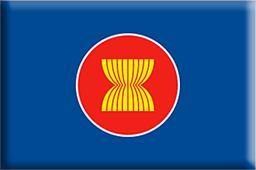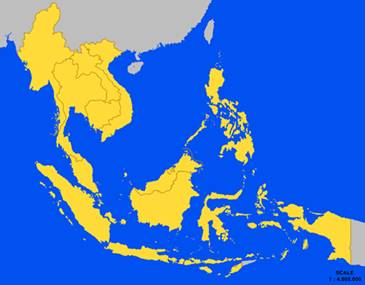(Updated as of August 2021)

Association of Southeast Asian Nations (ASEAN)
ESTABLISHMENT
The Association of Southeast Asian Nations, or ASEAN, was established on 8 August 1967 in Bangkok, Thailand, with the signing of the ASEAN Declaration (Bangkok Declaration) by the Founding Fathers of ASEAN, namely Indonesia, Malaysia, Philippines, Singapore and Thailand.
Brunei Darussalam then joined on 7 January 1984, Viet Nam on 28 July 1995, Lao PDR and Myanmar on 23 July 1997, and Cambodia on 30 April 1999, making up what is today the ten Member States of ASEAN.
AIMS AND PURPOSES
As set out in the ASEAN Declaration, the aims and purposes of ASEAN are:
1. To accelerate the economic growth, social progress and cultural development in the region through joint endeavours in the spirit of equality and partnership in order to strengthen the foundation for a prosperous and peaceful community of Southeast Asian Nations;
2. To promote regional peace and stability through abiding respect for justice and the rule of law in the relationship among countries of the region and adherence to the principles of the United Nations Charter;
3. To promote active collaboration and mutual assistance on matters of common interest in the economic, social, cultural, technical, scientific and administrative fields;
4. To provide assistance to each other in the form of training and research facilities in the educational, professional, technical and administrative spheres;
5. To collaborate more effectively for the greater utilisation of their agriculture and industries, the expansion of their trade, including the study of the problems of international commodity trade, the improvement of their transportation and communications facilities and the raising of the living standards of their peoples;
6. To promote Southeast Asian studies; and
7. To maintain close and beneficial cooperation with existing international and regional organisations with similar aims and purposes, and explore all avenues for even closer cooperation among themselves.
FUNDAMENTAL PRINCIPLES
In their relations with one another, the ASEAN Member States have adopted the following fundamental principles, as contained in the Treaty of Amity and Cooperation in Southeast Asia (TAC) of 1976:
1. Mutual respect for the independence, sovereignty, equality, territorial integrity, and national identity of all nations;
2. The right of every State to lead its national existence free from external interference, subversion or coercion;
3. Non-interference in the internal affairs of one another;
4. Settlement of differences or disputes by peaceful manner;
5. Renunciation of the threat or use of force; and
6. Effective cooperation among themselves.
ASEAN COMMUNITY
The ASEAN Vision 2020, adopted by the ASEAN Leaders on the 30th Anniversary of ASEAN, agreed on a shared vision of ASEAN as a concert of Southeast Asian nations, outward looking, living in peace, stability and prosperity, bonded together in partnership in dynamic development and in a community of caring societies.
At the 9th ASEAN Summit in 2003, the ASEAN Leaders resolved that an ASEAN Community shall be established.
At the 12th ASEAN Summit in January 2007, the Leaders affirmed their strong commitment to accelerate the establishment of an ASEAN Community by 2015 and signed the Cebu Declaration on the Acceleration of the Establishment of an ASEAN Community by 2015.
The ASEAN Community is comprised of three pillars, namely the ASEAN Political-Security Community (APSC), ASEAN Economic Community (AEC) and ASEAN Socio-Cultural Community (ASCC). Each pillar has its own Blueprint, and, together with the Initiative for ASEAN Integration (IAI) Strategic Framework and IAI Work Plan Phase II (2009-2015), they form the Roadmap for and ASEAN Community 2009-2015.
At the 25th ASEAN Summit in November 2014, the Leaders adopted Nay Pyi Taw Declaration on the ASEAN Community's Post-2015 Vision, endorsing the consolidated central elements annexed to the Declaration as a basis to develop the Post-2015 Vision of the ASEAN Community. The ASEAN Coordinating Council is tasked to oversee the overall process of developing the Post-2015 Vision and the attendant documents of the three community pillars of 2016-2025 to be submitted together to the 27th ASEAN Summit.
Leaders at the 26th ASEAN Summit in the Malaysian capital of Kuala Lumpur and northwestern resort island of Langkawi reaffirmed to make their utmost for the establishment of the ASEAN Community that is politically cohesive, economically integrated and socially responsible by the year-end of 2015 and agreed to tackle non-tariff barriers in order to further boost free movement of goods and services.
At the 27th ASEAN Summit in Kuala Lumpur, ASEAN 2025: Forging Ahead Together, which charts the path for ASEAN Community building over the next 10 years, was endorsed. The document is a forward-looking roadmap that articulates ASEAN goals and aspirations to realize further consolidation, integration and stronger cohesiveness as a community.
At its 28th and 29th ASEAN Summits held in Vientiane of Laos in 2016, the Leaders adopted the Initiative for ASEAN Integration (IAI) Work Plan III and the Master Plan on ASEAN Connectivity (MPAC) 2025, an integral part of the ASEAN 2025: Forging Ahead Together, in a bid to advance the ASEAN community building process.
Leaders at the 30th ASEAN Summit in Manila reaffirmed their commitment that the ASEAN Community Vision 2025 and the United Nations 2030 Agenda for Sustainable Development will be implemented in a mutually-reinforcing manner to build a truly inclusive and people-oriented, people-centered ASEAN Community.
At the 31st ASEAN Summit, Leaders signed the ASEAN Consensus on the Protection of the Rights of Migrant Workers that strengthens the social protection, access to justice, and ensures humane and fair treatment of the growing numbers of migrant workers in the region. They believed the document will help establish a framework for cooperation on migrant workers in the region and contribute to the ASEAN community building process.
ASEAN CHARTER
The ASEAN Charter serves as a firm foundation in achieving the ASEAN Community by providing legal status and institutional framework for ASEAN. It also codifies ASEAN norms, rules and values; sets clear targets for ASEAN; and presents accountability and compliance.
The ASEAN Charter entered into force on 15 December 2008. A gathering of the ASEAN Foreign Ministers was held at the ASEAN Secretariat in Jakarta to mark this very historic occasion for ASEAN.
With the entry into force of the ASEAN Charter, ASEAN will henceforth operate under a new legal framework and establish a number of new organs to boost its community-building process.
In effect, the ASEAN Charter has become a legally binding agreement among the 10 ASEAN Member States.
ASEAN CHAIR
According to Article 31 of the ASEAN Charter, the Chairmanship of ASEAN shall rotate annually, based on the alphabetical order of the English names of Member States. A Member State assuming the Chairmanship shall chair the ASEAN Summit and related summits, the ASEAN Coordinating Council, the three ASEAN Community Councils, relevant ASEAN Sectoral Ministerial Bodies and senior officials, and the Committee of Permanent Representatives.
Viet Nam is the Chair of ASEAN for 2020 and the theme of its ASEAN Chairmanship is "Cohesive and Responsive ASEAN".
Brunei Darussalam is the Chair of ASEAN for 2021 and the theme of its ASEAN Chairmanship is "We Care, We Prepare, We Prosper".
ASEAN MOTTO
The motto of ASEAN is "One Vision, One Identity, One Community".
ASEAN DAY
8th August is observed as ASEAN Day.
ASEAN SECRETARIAT
ASEAN Secretary-General (2018-2022): H.E. Dato Lim Jock Hoi
Headquarters: Jakarta
Basic Function: To provide for greater efficiency in the coordination of ASEAN organs and for more effective implementation of ASEAN projects and activities
Mission: To initiate, facilitate and coordinate ASEAN stakeholder collaboration in realizing the purposes and principles of ASEAN as reflected in the ASEAN Charter.
(Source: ASEAN Secretariat and relevant official documents)
ASEAN-10

|
Country
|
Land Area
(Thousands square km)
|
Population
(Thousands)
|
Major Language (S)
|
Capital City
|
Currency
|
GDP,current
prices (USD Billion)
|
| Brunei |
5.3 |
0.4 |
Malay, English |
Bandar Seri Begawan |
Brunei Dollar |
12.02 |
| Cambodia |
176.5 |
16.7 |
Khmer |
Phnom Penh |
Riel |
25.95 |
| Indonesia |
1,811.6 |
273.5 |
Indonesian |
Jakarta |
Rupiah |
1,060.00 |
| Lao PDR |
230.8 |
7.3 |
Lao |
Vientiane |
Kip |
19.08 |
| Malaysia |
328.6 |
32.4 |
Malay, English,
Chinese, Tamil |
Kuala Lumpur |
Ringgit |
338.28 |
| Myanmar |
653.1 |
54.4 |
Myanmar |
Nay Pyi Taw |
Kyat |
81.26 |
| Philippines |
298.2 |
109.6 |
Filipino,English,
Spanish |
Manila |
Peso |
362.24 |
| Singapore |
0.7 |
5.7 |
English, Malay,
Mandarin, Tamil |
Singapore |
Singapore Dollar |
339.98 |
| Thailand |
510.9 |
69.8 |
Thai |
Bangkok |
Baht |
501.89 |
| Viet Nam |
310.1 |
97.3 |
Vietnamese |
Ha Noi |
Dong |
340.82 |
(Source: Land Area - from World Bank World Development Indicators Database in 2018; Population - from World Bank World Development Indicators Database in 2020; Major Language(s), Capital City and Currency - from ASEAN Secretariat; GDP - from IMF World Economic Outlook, April 2021)




